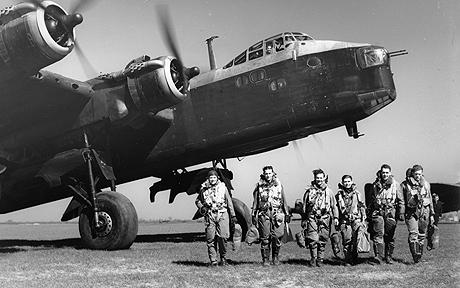The 7 Sqdn left from Oakington at 1942-06-26 at 23:20. Loc or duty Bremen
He flew with a Short Stirling (type I, serial N3754, code MG-O).
Campaign report of the USAAF:
(8th Air Force): Air echelons of the 31st Fighter Group are established at Atcham and High Ercall, England by this date. These are the first combat personnel of the VIII Fighter Command to reach the UK.
Campaign report of the RAF:
25/26 June 1942
Bremen
The 'Thousand Force' was reassembled for this raid, although only 960 aircraft became available for Bomber Command use. Every type of aircraft in Bomber command was included, even the Bostons and Mosquitos of 2 Group which, so far, had only been used for day operations. The force was composed as follows: 472 Wellingtons, 124 Halifaxes, 96 Lancasters, 69 Stirlings, 51 Blenheims, 50 Hampdens, 50 Whitleys, 24 Bostons, 20 Manchesters and 4 Mosquitos.
A further 102 Hudsons and Wellingtons of Coastal Command were sent to Bremen. 5 further aircraft provided by Army Co-Operation Command were also added to the force. The final numbers dispatched, 1,067 aircraft.
Parts of the force were allocated to specific targets in Bremen. The entire 5 Group effort - 142 aircraft - was ordered to bomb the Focke-Wulf factory; 20 Blenheims were allocated to the A.G. Weser shipyard; the Coastal Command aircraft were to bomb the Deschimag shipyard; all other aircraft were to carry out an area attack on the town and docks.
The tactics were basically similar to the earlier 'Thousand' raids except that the bombing period was now cut to 65 minutes. Bremen, on the wide River Weser, should have been an easy target to find and the inland penetration of the German night-fighter belt was only a shallow one. There were doubts about a band of cloud which lay across the Bremen area during the day, but this was being pushed steadily eastwards by a strong wind. Unfortunately the wind dropped in the evening and the bomber crews found the target completely covered for the whole period of the raid. The limited success which was gained was entirely due to the use of Gee, which enabled the leading crews to start fires, on to the glow of which many aircraft of later waves bombed. 696 Bomber Command aircraft were able to claim attacks on Bremen.
572 houses were completely destroyed and 6,108 damaged. 85 people were killed, 497 injured and 2,378 bombed out.
On the industrial side, an assembly shop at the Focke-Wulf factory was completely flattened, a further 6 buildings at this factory were seriously damaged and 11 buildings lightly so. Damage was also experienced by 4 important industrial firms - the Atlas Werke, the Vulkan shipyard, the Norddeutsche Hütte and the Korff refinery - and by 2 large dockside warehouses.
The actual losses of the Bomber Command aircraft involved in the raid were 48 aircraft, including 4 which came down in the sea near England from which all but 2 crew members were rescued. This was a new record loss. It represented exactly 5 per cent of the Bomber Command aircraft dispatched. This time, heaviest casualties were suffered by the OTUs of 91 Group, which lost 23 of the 198 Whitleys and Wellingtons provided by that group, a loss of 11.6 per cent. 5 of the 102 Coastal Command aircraft were also lost.
Intruder Operations: 56 aircraft of 2 Group - 31 Blenheims, 21 Bostons, 4 Mosquitos - were dispatched to attack and harass 13 German airfields. 15 of the Blenheims were lent by Army Co-Operation Command and were operating under Bomber Command orders. The Boston and Mosquito sorties were the first Intruder flights by those aircraft types. 2 of the Army Co-Operation Blenheims, attacking St Trond and Venlo airfields, were lost.
Total Bomber Command effort for the night: 1,016 sorties, 50 aircraft (4.9 per cent) lost. Total including Coastal Command: 1,123 sorties, 55 aircraft (4.9 per cent) lost.
26 June 1942
12 Bostons attacked Le Havre power-station but the bombing fell outside the target area. 2 Mosquitos photographed Bremen. 2 further Mosquitos to Essen turned back. No aircraft lost.
26/27 June 1942
Minelaying: 29 Wellingtons and 10 Halifaxes off Lorient and St Nazaire and in the Frisian Islands. No losses.
With thanks to the RAF and USAAF.net!
This record can also be found on the maps of Back to Normandy with Google coordinates. You can find the maps by clicking on this link on this location.
There are several possibilities to investigate the flight records on Back to Normandy. All the flights are plotted on maps, sorted "day by day", "by squadron", "by type aircraft", "by year or month", "by location" and much more! Don't miss this!!!
If you have any information that you want to share, please add your comment at the bottom of this record. Or send your information to [email protected]. This information will be added to the record.
Your photos and your information are very welcome! The young do care and with your help we keep up the good work.



